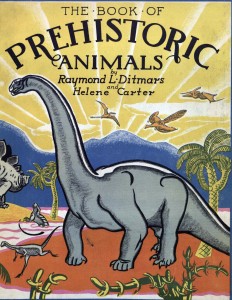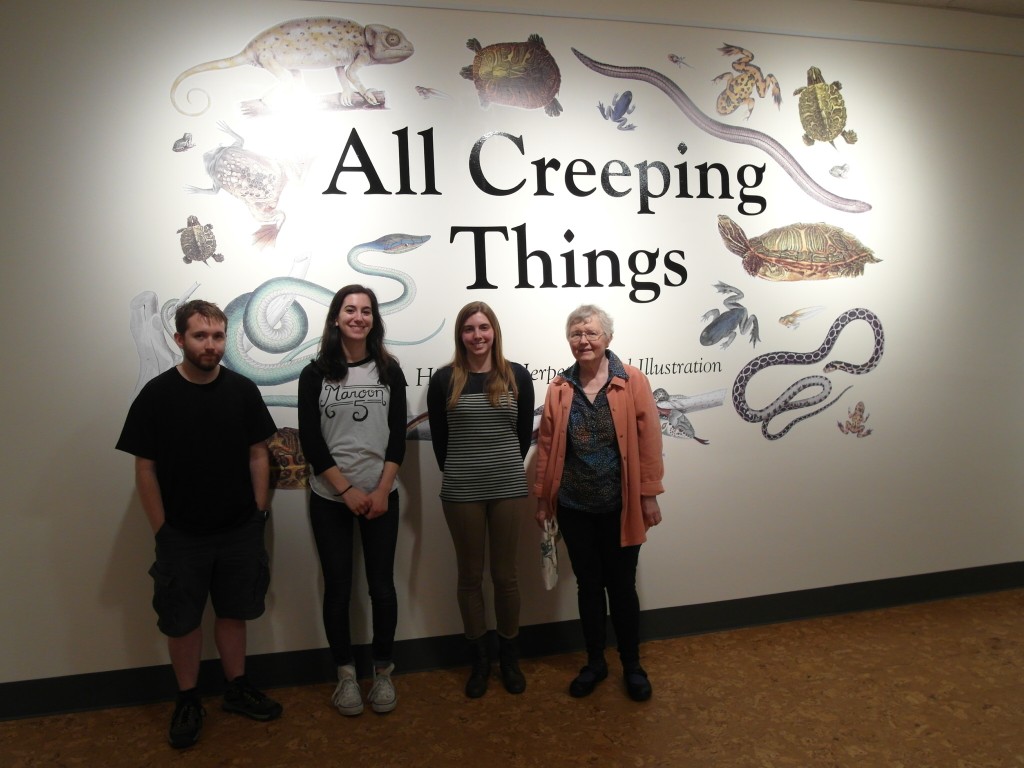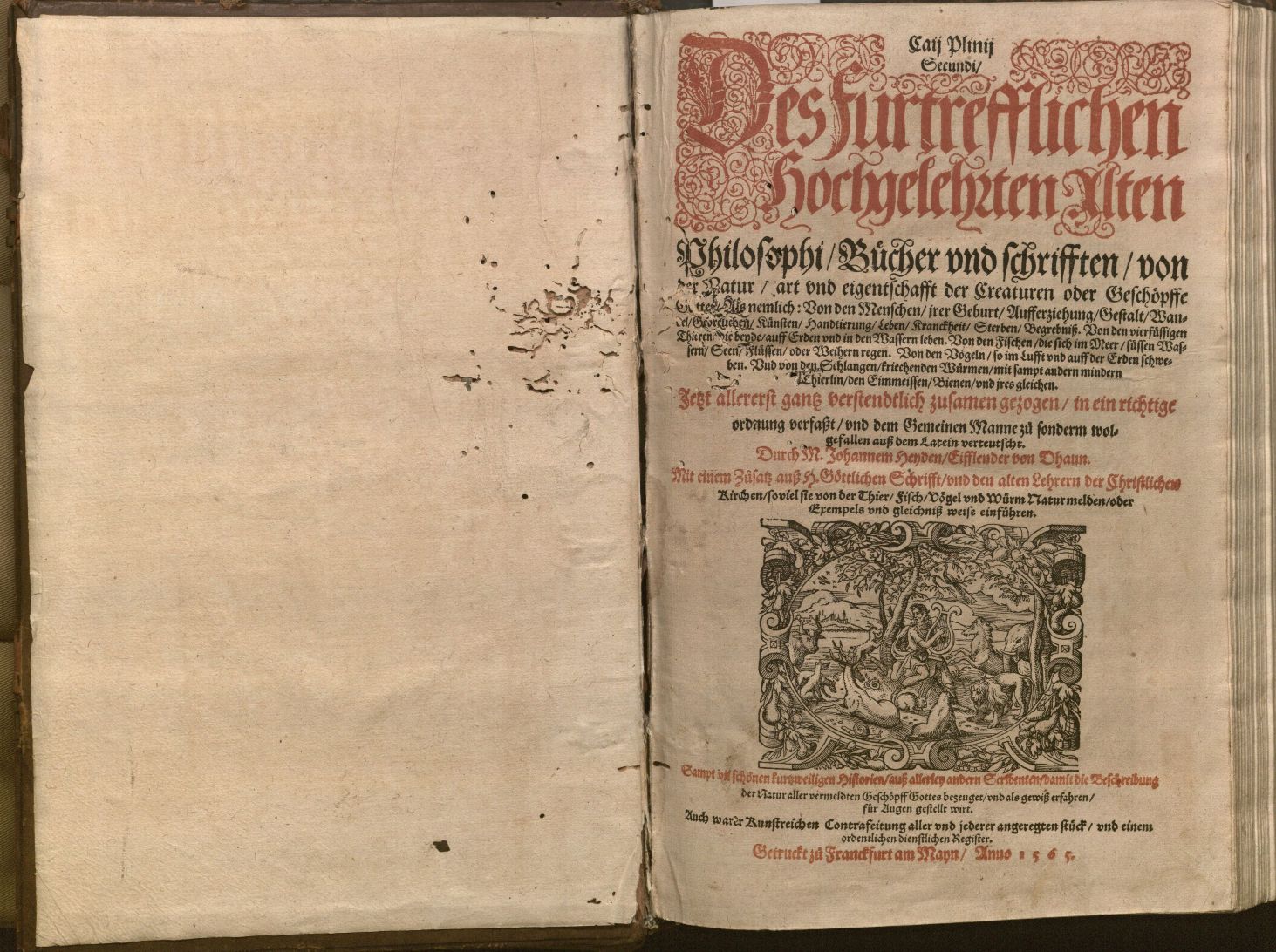October 17th, 2016 Many a 20th century herpetologist credits his or her early interest in herpetology to the books of Raymond Ditmars. He published eight books on amphibians and reptiles for children and adults alike and, although many professionals consider him merely a popularizer and a showman, his scientific and public contributions to herpetology were substantial. When he was hired as Assistant Curator in charge of reptiles at the Bronx Zoo in 1899, his personal collection of reptiles formed the nucleus of the zoo’s collection. Later on in his career, he was active in developing techniques for curing reptile diseases, produced nature movies, created a clearing house for distribution of antivenins produced in Brazil, and co-founded an American antivenin institute. He was a popular lecturer as well.

Raymond Lee Ditmars. The Book of Prehistoric Animals, 1935. Ellis Omnia D50
Although this volume (and several others authored by Ditmars) is from the Ellis Collection of natural history, the Department of Special Collections also has a collection of children’s literature, more than 7,000 volumes from the late 18th to early 20th century, including lots of natural history. In fact, books for children, from a 16th-century gardening manual to 20th-century science fiction, turn up in almost all of our collections, and in them, herps abound.
Sally Haines
Rare Book Cataloger
Adapted from her Spencer Research Library exhibit and catalog, Slithy Toves: Illustrated Classic Herpetological Books at the University of Kansas in Pictures and Conversations
Tags: Children's Books, Herpetology, Raymond Lee Ditmars, Sally Haines, Slithy Toves
Posted in Special Collections |
No Comments Yet »
May 26th, 2015 All Creeping Things: A History of Herpetological Illustration, Spencer Library’s newest exhibit, opened on May 14, 2015. Guided by Special Collections Librarian Karen Cook, students Megan Sims, Sydney Goldstein, and Ryan Ridder created and installed the exhibit for an exhibit planning and design course (MUSE 703). Whitney Baker, Head of Conservation Services at KU Libraries, Special Collections Librarian Sally Haines, and Caitlin Donnelly, Head of Public Services at Spencer, also assisted the students with their project.
The exhibit was developed in conjunction with the Society for the Study of Amphibians and Reptiles conference being held at the University of Kansas in July and features herpetological illustrations from seventeenth-, eighteenth-, and nineteenth-century books in Spencer Library’s Special Collections. Spencer has put on a few iterations of a similar exhibit for previous conferences. Each student had a unique perspective on their experience creating the exhibit.
Ryan Ridder
“One of our goals was to be distinct from Slithy Toves [a previous exhibit, by Sally Haines] and to present images that viewers familiar with that exhibition, and associated book, might not see as often. We ended up repeating a few irresistible images – the giant salamander, Agassiz’s turtles, and the famous frontispiece to Rössel von Rosenhof’s frog volume – but everything else you see is different. We thought touching on embryological illustrations would give our exhibit another unique slant.”

Megan Sims and Ryan Ridder installing books in the cases. Click image to enlarge.
Sydney Goldstein
“I found this class to be both an overwhelming and an incredibly eye-opening experience. Coming from a graphic design background I’ve never gone through the steps of curating an exhibition or working off the computer. It was fun to rummage through a variety of books to select illustrations, figuring out how they will fit in the cases, selecting wall graphics, and working in a group. The most rewarding part was applying our vinyl title graphic ourselves. Overall, a great experience!”

Megan, Sydney, and Ryan hanging the vinyl title graphic.
Megan Sims
“I have installed many exhibits according to specific designs from clients, but this was my first experience selecting objects, designing signs and labels, and fabricating book mounts and wall graphics for an exhibit. Both the physical process and communication were challenging at times, but seeing the finished product was very rewarding. I’m excited for the conference members and the Lawrence community to see this exhibit!”

Ryan Ridder, Sydney Goldstein, Megan Sims, and curator Karen Cook. Click image to enlarge.
All Creeping Things is free and open to the public through August 2015.
Megan Sims
Museum Studies Graduate Student
Tags: Caitlin Donnelly, Herpetology, history of science, Karen S. Cook, Megan Sims, Mounting an exhibition, Museum Studies, Ryan Ridder, Sally Haines, Slithy Toves, Sydney Goldstein, Whitney Baker
Posted in Events, Exhibitions, Special Collections |
No Comments Yet »
October 18th, 2013 Sir Joseph Fayrer’s account of the Thanatophidia is important as a classic, systematic account of the venomous snakes of India. This second edition (the first was in 1872) was improved with the addition of text, even though the 31 lithographs (including 28 chromolithos) are identical in both editions.
Fayrer conducted extensive studies of the poison apparatus in Indian snakes and was responsible for many advances in the treatment of snakebite, including the use of potassium permanganate, of which he was the originator.

Above: Plate 8 (Ophiophagus Elaps) from Joseph Fayrer’s The Thanatophidia of India, second edition. London: J. and A. Churchill, 1874. Call Number: H199. Click image to enlarge.
The venomous snakes, and by extension all snakes, get a bad rap for what is primarily an extremely efficient food-getting mechanism, only secondarily defensive. Unless they are themselves attached, they kill other animals only for food. How else to get supper without either arms or legs? For a snake, there’s constriction or there’s fangs, although the spitting cobras of Africa send their poison by air-mail, blinding their victim. There is some question among herpetologists about whether the black mamba (the largest venomous snake in Africa) or the cobra, shown here in a very striking pose, will actually attack a human. Most snakes will try to escape a predator. In the United States, some species, such as the cottonmouth, will stand their ground and strike if the unwary come to close.
Sally Haines
Rare Books Cataloger
Adapted from her Spencer Research Library exhibit and catalog, Slithy Toves: Illustrated Classic Herpetological Books at the University of Kansas in Pictures and Conservations
Tags: Joseph Fayrer, poison, Sally Haines, Slithy Toves, snakes, Thanatophidia of India, zoological illustration
Posted in Exhibitions, Special Collections |
No Comments Yet »
February 8th, 2013 Pliny the Elder, that most famous and trustworthy of the ancient Roman naturalists, was too curious about natural phenomena for his own good; as every school-child knows, he was asphyxiated by volcanic dust and gasses when he went to investigate the same eruption of Vesuvius that destroyed Pompeii in 79 A.D.
Aristotle and Pliny are the names that come to mind when we think of naturalists of the ancient world. Aristotle was the originator of biological classification; in contrast to the Biblical groups of animals as “clean” or “unclean,” he established categories based primarily on anatomical and other observable characteristics. His was a coherent natural system. The Spencer Library has several editions of Aristotle’s Historia Animalium, the earliest printed in 1493.
The only surviving work of Pliny is the encylopedic Naturalis Historia, the earliest extant manuscript of which dates from the 10th century.** His work was a compilation of all the animals and plants that he knew of or had heard about, and contained little that was original. He was not yet a systematist and there was little order in his arrangement, but we have him to thank for the survival of some of the writings of others, and he is regarded as THE authority on natural history from the days of Imperial Rome through the Middle Ages.


Pliny, the Elder. Caji Plinii Secundi … Bücher und Schrifften von der Natur, Art und Eigenschafft der Creaturen oder Geschöpfe Gottes … [Naturalis historia. German.] Franckfurt am Mayn : Feyrabend und Hüter, 1565. Call Number: Summerfield E1059. Click images to enlarge.
Beginning with the earliest printing of Pliny in 1469, there were at least 42 printings in numerous languages, including English, before 1536. The Kenneth Spencer Research Library houses 21 separate editions produced between 1476 and 1685. This German version contains books 7-10 and part of book 11. The translation was made by J. Heyden Eifflender von Dhaun and is illustrated with woodcuts by Jost Amman and Virgil Solis.
Sally Haines
Rare Books Cataloger
Adapted from her Spencer Research Library exhibit and catalog, Slithy Toves: Illustrated Classic Herpetological Books at the University of Kansas in Pictures and Conservations
**Author’s Note: This is the information we had at the time of publication of Slithy Toves in 2000; Mr. Roger Pearse has recently pointed out that in fact there do exist fragments of 5th century codices of Pliny.
Tags: Aristotle, Bücher und Schrifften von der Natur, classification, Crocodiles, Historia Animalium, J. Heyden Eifflender von Dhaun, Jost Amman, natural history, Naturalis Historia, Pliny the Elder, Sally Haines, Slithy Toves, Virgil Solis
Posted in Exhibitions, Special Collections |
No Comments Yet »







